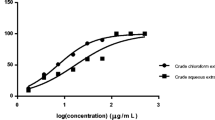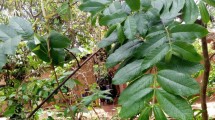Abstract
The antimalarial and antioxidant activities of methanolic extract of Nigella sativa seeds (MENS) were investigated against established malaria infection in vivo using Swiss albino mice. The antimalarial activity of the extract against Plasmodium yoelli nigeriensis (P. yoelli) was assessed using the Rane test procedure. Chloroquine (CQ)-treated group served as positive control. The extract, at a dose of 1.25 g/kg body weight significantly (p < 0.05) suppressed P. yoelli infection in the mice by 94%, while CQ, the reference drug, produced 86% suppression when compared to the untreated group after the fifth day of treatment. P. yoelli infection caused a significant (p < 0.05) increase in the levels of red cell and hepatic malondialdehyde (MDA), an index of lipid peroxidation (LPO) in the mice. Serum and hepatic LPO levels were increased by 71% and 113%, respectively, in the untreated infected mice. Furthermore, P. yoelli infection caused a significant (p < 0.05) decrease in the activities of superoxide dismutase, catalase, glutathione-S-transferase and the level of reduced glutathione in tissues of the mice. Treatment with MENS significantly (p < 0.05) attenuated the serum and hepatic MDA levels in P. yoelli-infected mice. In addition, MENS restored the activities of red cell antioxidant enzymes in the infected mice to near normal. Moreover, MENS was found to be more effective than CQ in parasite clearance and, in the restoration of altered biochemical indices by P. yoelli infection. These results suggest that N. sativa seeds have strong antioxidant property and, may be a good phytotherapeutic agent against Plasmodium infection in malaria.




Similar content being viewed by others
References
Aebi H (1974) Methods of enzymatic analysis. In: Bergmeyer HV (ed) catalase estimation. Verlag Chemic, New York, pp 673–684
Ajaiyeoba EO, Abiodun OO, Falade MO, Ogbole NO, Ashidi JS, Happi CT, Akinboye DO (2006) In vitro cytotoxicity studies of 20 plants used in Nigerian antimalarial ethnomedicine. Phytomedicine 13:295–298
Al-Naggar TB, Gomez-Serranillos MP, Carretero ME, Villar AM (2003) Neuropharmacological activity of Nigella Sativa L. extracts. J Ethnopharmacol 88:63–68
Areekul S, Boonme Y (1986) Catalase activity in red cell and liver of mice infected with Plasmodium berghei. Southeast Asian J Trop Med Public Health 17:48–52
Burits M, Bucar F (2000) Antioxidant activity of Nigella sativa L. essential oil. Phytother Res 14:323–328
Butler D, Maurice J, O'Brien C (1997) Time to put malaria control on the global agenda. Nature 386:535–536
Daba MH, Abdel-Rahman MS (1998) Hepatoprotective activity of thymoquinone in isolated rat hepatocytes. Toxicol Lett 95:23–29
El-Dakhakhny M, Barakat M, Abd-El-Halim M, Aly SM (2000) Effects of Nigella sativa oil on gastric secretion and ethanol induced ulcer in rats. J Ethnopharmacol 72:299–304
El-Daly ES (1998) Protective effect of cysteine and Vitamin E, Crocus sativus and Nigella sativa extracts on cisplatin-induced toxicity in rats. J Pharm Belg 53:87–95
El-Shabrawy OA, Nada SA (1996) Biological evaluation of multicomponent tea used as hypoglycemic in rats. Fitoterapia 67:99–102
El-Tahir KEH, Ashour MMS, Al-Harbi MM (1993) The respiratory effects of the volatile oil of the black seed (Nigella sativa) in guinea-pigs: elucidation of the mechanism(s) of action. Gen Pharmacol 24:1115–1122
Elufioye TO, Agbedahunsi JM (2004) Antimalarial activities of Tithonia diversifolia (Asteraceae) and Crossopteryx febrifuga (Rubiaceae) on mice in vivo. J Ethnopharmacol 93:167–171
Fabricant DS, Farnsworth NR (2001) The value of plants used in traditional medicine for drug discovery. Environ Health Perspect 109:69–75
Farombi EO, Shyntum YY, Emerole GO (2003) Influence of chloroquine treatment and Plasmodium falciparum malaria infection on some enzymatic and non-enzymatic antioxidant defense indices in humans. Drug Chem Toxicol 26:59–71
Gessler MC, Nkunya MH, Mwasumbi LB, Heinrich M, Tanner M (1994) Screening Tanzanian medicinal plants for antimalarial activity. Acta Trop 56:65–77
Gornall AG, Bardawill CJ, David MM (1949) Determination of serum proteins by means of the biuret reaction. J Biol Chem 177:751–766
Habig WH, Pabst MJ, Jakoby WB (1974) Glutathione-S-transferases. The first enzymatic step in mercapturic acid formation. J Biol Chem 249:7130–7139
Houghton PJ, Zarka R, Heras B, Hoult RS (1995) Fixed oil of Nigella sativa and derived thymoquinone inhibit eicosanoid generation in leukocytes and membrane lipid peroxidation. Planta Med 61:33–36
Jollow DJ, Mitchell JR, Zampaglione N, Gillette JR (1974) Bromobenzene-induced liver necrosis. Protective role of glutathione and evidence for 3, 4-bromobenzene oxide as the hepatotoxic metabolite. Pharmacol 12:251–271
Khanna T, Zaidi FA, Dandiya PC (1993) CNS and analgesic studies on Nigella sativa. Fitoterapia 64:407–410
Lautenbacher LM (1997) Schwarzkümmelöl. Dtsch Apoth Ztg 137:68–69
Lüersen K, Walter RD, Müller S (2000) Plasmodium falciparum infected red blood cells depend on a functional glutathione de novo synthesis attributable to an enhanced loss of glutathione. Biochem J 346:545–552
Mahmoud MR, El-Abhar HS, Saleh S (2002) The effect of Nigella sativa oil against the liver damage induced by Schistosoma mansoni infection in mice. J Ethnopharmacol 79:1–11
McCord JM, Fridovich I (1969) Superoxide dismutase, an enzymatic function for erythrocuperin. J Biol Chem 244:6049–6055
Mouhajir F, Pedersen JA, Rejdali M, Towers GHN (1999) Antimicrobial thymohydroquinones of Moroccan Nigella sativa seeds detected by electron spin resonance. Pharm Biol 37:391–395
Muregi FW, Chhabra SC, Njagi EN, Langàt-Thoruwa CC, Njue WM, Orago AS, Omar SA, Ndiege IO (2003) In vitro antiplasmodial activity of some plants used in Kisii, Kenya against malaria and their chloroquine potentiation effects. J Ethnopharmacol 84:235–239
Mutabagani A, El-Mahdy SAM (1997) A study of the anti-inflammatory activity of Nigella sativa L. and thymoquinone in rats. Saudi Pharm J 5:110–113
Ogunbayo OA, Adisa RA, Ademowo OG, Olorunsogo OO (2006) Incidence of chloroquine induced oxidative stress in the blood of rabbit. Intl J Pharmacol 2:121–125
Pasvol G (1998) The treatment of falciparum malaria in African children. Afr Health 20:19–20
Rodrigues JR, Gamboa ND (2009) Effect of dequalinium on the oxidative stress in Plasmodium berghei-infected erythrocytes. Parasitol Res 104:1491–1496
Türkdoğan MK, Ozbek H, Yener Z, Tuncer I, Uygan I, Ceylan E (2003) The role of Urtica dioica and Nigella sativa in the prevention of carbon tetrachloride-induced hepatotoxicity in rats. Phytother Res 17:942–946
Varshney R, Kale RK (1990) Effects of calmodulin antagonists on radiation-induced lipid peroxidation in microsomes. Int J Radiat Biol 58:733–743
Wiseman H, Halliwell B (1996) Damage to DNA by reactive oxygen and nitrogen species: role in inflammatory disease and progression to cancer. Biochem J 313:17–29
Zaoui A, Cherrah Y, Lacaille-Dubois MA, Settaf A, Amarouch H, Hassar M (2000) Diuretic and hypotensive effects of Nigella sativa in the spontaneously hypertensive rat. Therapie 55:379–382
Zaoui A, Cherrah Y, Alaoui K, Mahassine N, Amarouch H, Hassar M (2002) Effects of Nigella sativa fixed oil on blood homeostasis in rat. J Ethnopharmacol 79:23–26
Author information
Authors and Affiliations
Corresponding author
Rights and permissions
About this article
Cite this article
Okeola, V.O., Adaramoye, O.A., Nneji, C.M. et al. Antimalarial and antioxidant activities of methanolic extract of Nigella sativa seeds (black cumin) in mice infected with Plasmodium yoelli nigeriensis . Parasitol Res 108, 1507–1512 (2011). https://doi.org/10.1007/s00436-010-2204-4
Received:
Accepted:
Published:
Issue Date:
DOI: https://doi.org/10.1007/s00436-010-2204-4




